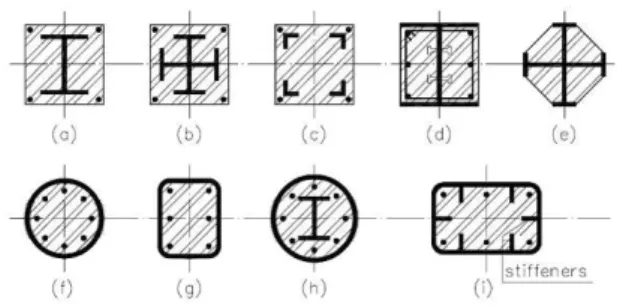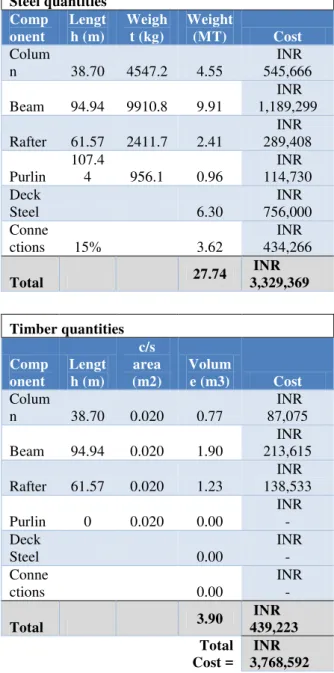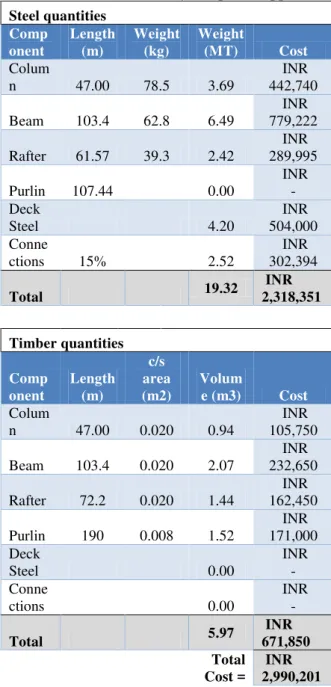Charuhas K. Karalkar Int. Journal of Engineering Research and Applications
www.ijera.com
ISSN : 2248-9622, Vol. 5, Issue 5, ( Part -5) May 2015, pp.88-92
Comparative Study of Structure Using Composite Members And
Conventional Members
Charuhas K. Karalkar*, Dr. Uttam B. Kalwane **
*( PG Student, Department of Civil Engineering, Dr. D Y Patil School of Engineering & Technology, Lohegaon, Savitribai Phule Pune University, Pune – 411014)
** (Guide and Principal at Dr. D Y Patil School of Engineering & Technology, Lohegaon, Savitribai Phule Pune University, Pune – 411014)
ABSTRACT
There are different methods of construction for building structure. The most popular conventional structures used are reinforced cement concrete structures, pure steel structures and Timber Structures. In the modern age the rapid growth in population and continuous influx of people from rural to metros; buildings are constructed on a large scale and with great Architectural requirement.
In this paper a new type of structure is introduced which involves use of composite members. To reduce the construction time, material quantity and cost the composite members are used. The composite members here mean use of steel sections as structural steel along with timber. Here by using composite members for miscellaneous Architectural building, lot of saving has been done in material, construction time and cost. It saves approximately 20-25% cost of structure if conventional type is used. Composite members used are Structural steel and solid timber compare to conventional steel or RCC members.
Keywords
- Conventional type frame structure, composite member frame structure, Light frame structure, timber steel composite, Cost AnalysisI.
INTRODUCTION
The most important and most frequently encountered combination of construction materials is that of steel and concrete, with applications in multi-storey commercial buildings and factories, as well as in bridges. These materials can be used in mixed structural systems in composite structures where members consisting of steel and concrete act together compositely. Here, in this paper use steel and timber hybrid structure is focused. In conventional practice RCC / structural steel members are used in building structures. But due to Architectural requirement cladding is used in some cases to give aesthetic looks. This increases cost of structure. Hence, if we use composite material then, it saves a lot of material, time and ultimately costing. Benefits of using steel in timber include increase in tensile capacity, seismic performance, and cost savings.
These essentially different materials are completely compatible and complementary to each other. Steel and timber materials are used to form composite members which increase the serviceability of structure during earthquake and wind prone areas. Steel has more thermal expansion than the wood. This forms ideal combination of strength with the timber efficient in compression and the steel in tension. By using steels connections will allow timber buildings to survive and remain serviceable after earthquakes, reducing death tolls as well as repair and business interruption costs.
The extent to which the components of a building structure should embody all the steel construction, be constructed entirely in reinforced concrete, in timber construction, or be of composite construction depends on circumstances. However engineers are increasingly designing composite and mixed building systems of structural steel and reinforced concrete or structural steel and timber to produce more efficient structures when compared to designs using either material alone. Timber and steel composite members mainly use for light frame structures.
II.
OBJECTIVE
OF
THE
STUDY
The light frame structures (Timber Structures) are more susceptible to damage due to earthquake and heavy wind. Due to this fact the modern techniques of construction involves use of moment resisting frames. The use of composite members suggested in this report may prove to be seismic and wind resistant over conventional technique used for such type of buildings.
The main objective of the present paper is to capture the modified performance of the building using composite member against regular members and its cost comparison with conventional steel/ timber building structure. For this one miscellaneous light frame building structure located near Pune is considered. It is observed that the structure with purely steel structure may have more efficient than timber structure, only when the overall form of
Charuhas K. Karalkar Int. Journal of Engineering Research and Applications
www.ijera.com
ISSN : 2248-9622, Vol. 5, Issue 5, ( Part -5) May 2015, pp.88-92
building is regular and it is possible to use bracing at least along the longer direction without hampering the aesthetics of building. In India mostly buildings are irregular in shapes due to which aesthetic requirements of building cannot be fulfilled by only steel construction. Hence, a comparative study of Structural Steel and composite member construction is carried out in this report.
III.
C
HOICE OF MATERIALS1. Structural Materials
Nowadays basic framing materials for the building construction are steel, concrete and wood. Availability of material, cost, adequate knowledge of design and construction, maintenance and modification are some of influencing factors in selecting the material of construction. Here, we are considering steel and timber material due to aesthetic requirement of structure. Both the materials have their own advantages and limitations. Combining steel and wood will increase the seismic performance of the structure. Wood has a high strength to weight ratio therefore wood buildings tend to be lighter than other building types [8]. Table below shows a comparison of strength/density ratios for some structural materials. For pure wood this ratio is significantly higher than other building materials [4].
Table 1: Strength/density ratios structural materials 2. Advantages of composite members
The advantages of using steel timber composite members may be emulated as: -
a. Considerable flexibility to structure when there is sudden increase of load by dissipating energy. b. Ease of fabrication with skilled technique
facilitates faster erection of structure.
c. Enables easy construction schedule in congested sites.
d. Light weight of material eases the transport at remote located sites.
e. Satisfies requirement of long span construction, a modern trend in architectural design.
f. Permits easy structural repair and modification for antique structure.
g. Ideal material in earthquake prone/ heavy wind prone locations due to high strength, stiffness and ductility.
h. Properly designed composite steel and wood members prevent the tensile failure mode of wood members and have significant ductility.
i. The size of the members can be made smaller thus increasing strength to weight ratios.
IV.
TYPES
OF
COMPOSITE
SECTIONS
A composite column is defined as a compression member which may either be a concrete encased section or a concrete filled hollow section or a steel sandwich between timber sections:-
1. Steel - Concrete Composite
According to the shape of the cross-section, there are mainly three different types of steel concrete composite members as:-
a. Concrete-encased sections (as shown a, b and c below)
b. Concrete-filled hollow sections (as shown f, g and i below)
c. Partly concreted-encased sections (as shown d and e below).
Fig.1:- Typical cross-sections of steel -concrete composite
2. Steel - Timber Composite
Steel – Timber composites frequently called as flitch type me
mbers. The cross sections are as shown in figure below. In these types of sections, mainly steel plates pressed between different timber sections and connected through nuts, bolts or pins. Typical cross section is as below from betterheader [13]:-
Charuhas K. Karalkar Int. Journal of Engineering Research and Applications
www.ijera.com
ISSN : 2248-9622, Vol. 5, Issue 5, ( Part -5) May 2015, pp.88-92
V.
B
ASIC CONCEPTS IN ANALYSIS AND DESIGN OF COMPOSITESTRUCTURE
1. Case Study: Miscellaneous light Frame Arch. Structure
Here, for comparative study the following light frame miscellaneous structure is considered. This structure is situated near Pune. Below picture shows the Architectural concept required.
Fig.3:- Architectural Concept of Building-3D view 2. Structural Concept with Conventional
Approach
STAAD Pro software is used to create model of the structure and design by conventional approach. The whole structure is divided into three different parts mainly for analysis and design purpose.
Fig.4:- Structural model for conventional approach By conventional method Structural steel members are used and timber is used as cladding to fulfill the Architectural requirement.
The analytical results are used to design the steel members by using STAAD Pro Software. The members are designed with reference to IS 800. 3. Structural Concept with composite member
Approach
By composite member approach Structural steel / pure timber members are replaced by composite flitch type members composed of steel as shown in fig. 2. SCIA and REVIT software is used for modeling and analysis of structure.
Fig. 6:- Structural model for composite structure
The analytical results are used to design the composite members by using excel spreadsheets. The composite members are designed with reference to EN1995-1-1:2004 [1] [2] [3].
VI.
RESULTS
AND
COMPARISON
Quantities for Structure_By Conventional Approach
Steel quantities Comp
onent
Lengt h (m)
Weigh t (kg)
Weight
(MT) Cost Colum
n 38.70 4547.2 4.55
INR 545,666 Beam 94.94 9910.8 9.91
INR 1,189,299 Rafter 61.57 2411.7 2.41
INR 289,408 Purlin
107.4
4 956.1 0.96
INR 114,730 Deck
Steel 6.30
INR 756,000 Conne
ctions 15% 3.62
INR 434,266
Total 27.74
INR 3,329,369
Timber quantities
Comp onent
Lengt h (m)
c/s area (m2)
Volum
e (m3) Cost Colum
n 38.70 0.020 0.77
INR 87,075 Beam 94.94 0.020 1.90
INR 213,615 Rafter 61.57 0.020 1.23
INR 138,533
Purlin 0 0.020 0.00
INR - Deck
Steel 0.00
INR - Conne
ctions 0.00
INR -
Total 3.90
INR 439,223 Total
Cost =
Charuhas K. Karalkar Int. Journal of Engineering Research and Applications
www.ijera.com
ISSN : 2248-9622, Vol. 5, Issue 5, ( Part -5) May 2015, pp.88-92
Quantities for Structure_By composite Approach
Steel quantities Comp onent Length (m) Weight (kg) Weight
(MT) Cost Colum
n 47.00 78.5 3.69
INR 442,740
Beam 103.4 62.8 6.49
INR 779,222 Rafter 61.57 39.3 2.42
INR 289,995
Purlin 107.44 0.00
INR - Deck
Steel 4.20
INR 504,000 Conne
ctions 15% 2.52
INR 302,394
Total 19.32
INR 2,318,351 Timber quantities Comp onent Length (m) c/s area (m2) Volum
e (m3) Cost Colum
n 47.00 0.020 0.94
INR 105,750
Beam 103.4 0.020 2.07
INR 232,650 Rafter 72.2 0.020 1.44
INR 162,450
Purlin 190 0.008 1.52
INR 171,000 Deck
Steel 0.00
INR - Conne
ctions 0.00
INR -
Total 5.97
INR 671,850 Total Cost = INR 2,990,201
The above values are calculated for partial area of the structure i.e. deck area.
This shows the total cost saving using composite material compared to conventional method lies between 20%- 25%.
Figure captions appear below the figure, are flush left, and are in lower case letters. When referring to a figure in the body of the text, the abbreviation "Fig." is used. Figures should be numbered in the order they appear in the text.
Table captions appear centered above the table in upper and lower case letters. When referring to a table in the text, no abbreviation is used and "Table" is capitalized.
VII.
C
ONCLUSIONThe comparison of Analysis and design results of building using composite members and steel members shows that:-
a. Overall of costing of structure by using composite member is reduced by 20% to 25% than that of steel / timber members.
b. Cross-section dimension of composite members are lesser than that of pure timber members by 5% to 15%.
c. Good fire resistance and corrosion protection are achieved due to use of flitch type sections than that of purely steel / timber members.
R
EFERENCESDesign Standard Codes:
[1] Design loads, “Code of Practice for Design Loads for Buildings and Structures”, IS: 875 - 1987, Parts 1 to 5.
[2] IS : 1893 – 2002 Part 1, Seismic Design base shear, “Criteria for Earthquake Resistant Design of Structures”
[3] Member design “Design of timber
structures”, Eurocode 5: EN 1995-1-Part 1, Part 2.
Journal Papers:
[4] Yalda Khorasani, Zhina Siadat , University of British Columbia “Steel Timber Hybrid
Structures”, Civil 510, pg. 1-26.
[5] Richard Persaud, Dr Digby Symons, University of Cambridge, Department of Engineering, Trumpington Street, Cambridge, CB2 1PZ “Design and testing of a composite timber and concrete floor
system”, The Structural Engineer – 21 February 2006, pp. 22-30.
[6] Parvez Alam, Martin Ansell (2012); “The Effects of Varying Nailing Density upon the
Flexural Properties of Flitch Beams”,
Journal of Civil Engineering Research 2012, 2(1), pp. 7-13.
[7] Parvez Alam (2004); “The Reinforcement of Timber for structural applications and
repair”, University of Bath, 2004, pg. 33-307.
[8] J D Wiesenfled (1989); “Glitches in Flitch
Beam Design”, Article, Civil Engineering, September 1989, pg. 65-66.
Study & Theses Reports:
[9] Jobin Jacob, Olga Lucia Garzon Barragan (2007); “Flexural Strengthening of Glued Laminated Timber Beams with Steel and
Carbon Fiber Reinforced Polymers”,
Charuhas K. Karalkar Int. Journal of Engineering Research and Applications
www.ijera.com
ISSN : 2248-9622, Vol. 5, Issue 5, ( Part -5) May 2015, pp.88-92
[10] Eva Frühwald, Erik Serrano, Tomi Toratti, Arne Emilsson, Sven Thelandersson (2007); “Design of safe timber structures”, Report, Lund Institute of Technology, Lund University, pg. 17-39.
Manuals and Books:
[11] Parvez Alam, Martin Ansell and Dave Smedley (2012); “Effects of Reinforcement Geometry on Strength and Stiffness in Adhesively Bonded Steel-Timber Flexural
Beams”, Buildings 2012, 2, pp 231-244; doi: 10.3390/buildings2030231.
[12] NAHB Builder’s Beam Manual, Flitch Plate-and Steel I-Beams, Washington, D.C. 20005, 1981.
URL Link:


